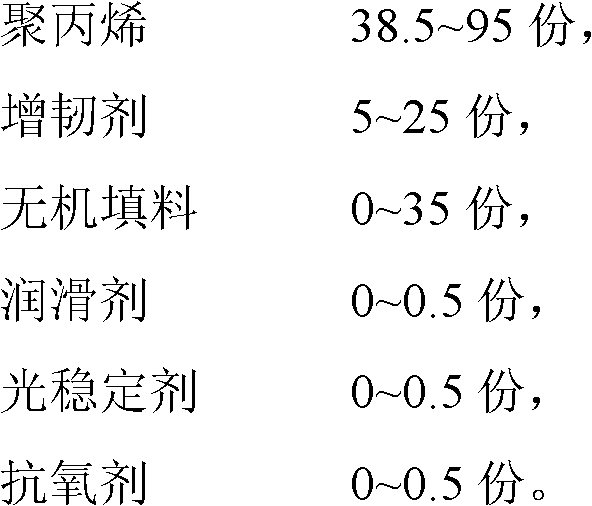Polypropylene composition and preparation method thereof
A polypropylene composition and polypropylene technology, applied in the field of polypropylene composition and its preparation, can solve the problems of uncompetitiveness and low cost performance, and achieve the effects of promoting development, low cost and high cost performance
- Summary
- Abstract
- Description
- Claims
- Application Information
AI Technical Summary
Problems solved by technology
Method used
Image
Examples
Embodiment 1
[0029] (1) Add untreated calcium carbonate and 0.1% (mass percentage of calcium carbonate) gamma-aminopropyltriethoxysilane into a high mixer and mix for 10 minutes, then discharge.
[0030] (2) Put 40 parts of new polypropylene material, 29 parts of recycled polypropylene material, 5 parts of calcium carbonate, 5 parts of ethylene-propylene-cyclopentadiene terpolymer (EPDM), 20 parts of recycled ethylene-propylene rubber, 0.5 parts Light stabilizer LS-770, 0.2 parts of antioxidant 1010, 0.3 parts of antioxidant 168, added to the above high mixer and mixed for 5 minutes;
[0031] (3) Put the mixture into the twin-screw extruder from the feeding port, extrude and granulate. The extrusion temperatures were 160°C, 225°C, 235°C, 235°C, and 240°C, respectively. The test performance data are as follows: tensile strength 19.8MPA, elongation at break 491%, flexural strength 22.3MPA, flexural modulus 1168MPA, notched impact strength 81KJ / M 2 .
Embodiment 2
[0033] (1) Add untreated glass powder and 2% (mass percentage of glass powder) of γ-aminopropyltriethoxysilane into a high-mixer and mix for 10 minutes, then discharge.
[0034] (2) 40 parts of new polypropylene material, 14 parts of recycled polypropylene material, 5 parts of ethylene-vinyl acetate copolymer, 5 parts of regenerated butadiene rubber, 35 parts of glass powder, 0.5 part of ethylene bis stearamide, 0.3 Part of light stabilizer 201, 0.1 part of antioxidant 1076, 0.1 part of triphenyl phosphite, added in the above-mentioned high mixer and mixed for 10 minutes;
[0035] (3) Put the mixture into the twin-screw extruder from the feeding port, extrude and granulate. The extrusion temperatures were 160°C, 225°C, 235°C, 235°C, and 240°C, respectively. The test performance data are as follows: tensile strength 28.8MPA, elongation at break 32%, flexural strength 38.1MPA, flexural modulus 1912MPA, notched impact strength 9.2KJ / M 2 .
Embodiment 3
[0037] (1) Add untreated glass microspheres and 1% (mass percentage of glass microspheres) of γ-aminopropyltriethoxysilane into a high mixer and mix for 5 minutes, then discharge.
[0038] (2) 20 parts of new polypropylene material, 49 parts of recycled polypropylene material, 5 parts of chlorinated polyethylene, 10 parts of regenerated butadiene rubber, 15 parts of glass microspheres, 0.3 part of oleic acid amide, 02 parts of light stabilizer 201 , 0.3 parts of antioxidant 1076, 02 parts of antioxidant DSTP, added to the above high mixer and mixed for 10 minutes;
[0039] (3) Put the mixture into the twin-screw extruder from the feeding port, extrude and granulate. The extrusion temperatures were 160°C, 225°C, 235°C, 235°C, and 240°C, respectively. The test performance data are as follows: tensile strength 22.5MPA, elongation at break 174%, flexural strength 31.3MPA, flexural modulus 1380MPA, notched impact strength 49.5KJ / M 2 .
PUM
| Property | Measurement | Unit |
|---|---|---|
| particle size | aaaaa | aaaaa |
| tensile strength | aaaaa | aaaaa |
| bending strength | aaaaa | aaaaa |
Abstract
Description
Claims
Application Information
 Login to View More
Login to View More - R&D
- Intellectual Property
- Life Sciences
- Materials
- Tech Scout
- Unparalleled Data Quality
- Higher Quality Content
- 60% Fewer Hallucinations
Browse by: Latest US Patents, China's latest patents, Technical Efficacy Thesaurus, Application Domain, Technology Topic, Popular Technical Reports.
© 2025 PatSnap. All rights reserved.Legal|Privacy policy|Modern Slavery Act Transparency Statement|Sitemap|About US| Contact US: help@patsnap.com


